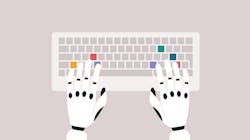ChatGPT: Will it revolutionize the dental industry?
The future of dental care is rapidly evolving, and technology plays a major role in shaping it. From CAD/CAM, 3D printing, digital impression and restorative manipulation, satellite navigation, and nanobots to chatbots, the use of artificial intelligence (AI) is becoming increasingly prevalent in the dental industry. These technologies allow collection and utilization of data from a growing number of sources, including those used by consumers, practitioners, and health-care systems, making AI uniquely well positioned to envelop dental medicine. According to recent research, the global AI-in-health-care market is expected to reach a staggering $187.95 billion by 2030.1 This rapid growth is primarily due to AI’s many benefits for health-care systems, professionals, and patients.
ChatGPT
An example of AI’s widespread adoption is ChatGPT by OpenAI, the powerful chatbot made available to the public through a free, easy-to-use web interface. First launched in November 2022, ChatGPT broke all records by attracting more than one million users within a week of its launch. It took Google four years to attract as many customers after its launch in 1994. Even Google’s management team had to issue a “code red” as the chatbot’s popularity sparked concerns over the company’s future as a search engine and Google to counter with the release of its own chatbot, Bard.
Open AI ChatGPT versus Google Bard
Both Google Bard and ChatGPT use natural language models and machine learning to create their chatbots, but each has a different set of features.2 At the time of this article’s publication, ChatGPT is entirely based on information that was mostly scraped or collected up until 2021. This may change with the collaboration of Open AI ChatGPT and Microsoft Bing. Google Bard has the potential to use current information for its responses as it will have the Google search engine information. ChatGPT has a conversational question-and-answer platform more capable of answering conversational questions. Microsoft Bing is now using this option in its search query. Google Bard will be used in the same way, but to augment Google exclusively.
Read more about AI in dentistry ...
Dentistry leads the AI revolution (despite its late arrival)
Tech and marketing trends that will impact the dental industry in 2023
Both chatbots are based on slightly different language models. Google Bard uses LaMBDA, while ChatGPT is built on GPT (Generative Pretrained Transformer). ChatGPT also includes a plagiarism detector, which Google Bard currently does not. Because ChatGPT is available now and Google Bard is only available to beta testers at the time of this article writing, the rest of this article will focus on ChatGPT.
How does it work?
ChatGPT, on its third and soon to be fourth version, is a language model trained on the entirety of human knowledge as expressed through language. Large language models are computer programs that predict the next word in a series of words; small-scale examples of this are already in use by Apple, Google, iMessage, Meta (Facebook), and other communication systems.
OpenAI summarizes ChatGPT’s training as “a method that models previously demonstrated texts created by humans to guide the model toward desired behavior.” As part of the process, the ChatGPT model was fed all articles, books, academic journals, reviews, online content, and everything ever written. As a result, it developed an internal weighting structure for predictions at run-time. In the background, the program itself utilizes reinforcement learning (RL) to reward the chatbot model based on user interactions and improve its accuracy through user-informed corrections (like training your brain through learning what is right or wrong). The more information it is fed and “trained,” the better it becomes.
Current uses and capabilities
From students completing research reports, to companies providing customer support, to companies using it to write computer code, the technology’s target demographic includes virtually everyone with access to a computer/mobile phone. The bot can write entire computer programs, in-depth articles with citations, novels, and poems in seconds when asked the correct questions. It can formulate business plans, give stock tips, analyze market trends, give gardening ideas, provide dinner recipes, and pick out the top restaurants for a date. One problem is that ChatGPT can only answer queries with information available prior to September 2021; it doesn’t have access to up-to-date search engine information (as of now).
Importance of ChatGPT
ChatGPT is a huge step forward in how humans interact with technology. The chatbot represents significant advancements in AI, and its groundbreaking popularity signals a willingness on the part of millions worldwide to embrace AI in their daily lives. ChatGPT has the potential to be used in many applications in the dental field, including providing diagnoses/prognoses, predicting caries and periodontal progression, answering difficult questions from patients, and creating complex conversations. Unlike most AI chatbots, ChatGPT is stateful, meaning it can remember and learn from previous conversations or RL.
In a recent preprint article, ChatGPT was fed the United States Medical Licensing Exam (USMLE) and it passed.3 This bot has also been fed law and business exams, passing with grades in the B range.4 Not to be outdone by OpenAI, Google recently launched MedPaLM, a large language model aligned to the medical domain by Google Research and DeepMind, with the potential for easily accessible AI-based medicine query.
Potential uses in dentistry
Reduce the number of staff needed and free dentists from routine tasks. ChatGPT has proven effective as an automation tool, reducing the burden of routine tasks from patient scheduling to chart dictation. AI technology can answer frequently asked patient questions, schedule appointments, manage bookings, and carry out simple tasks. Doctors in certain hospitals have already begun testing ChatGPT’s ability to ease their daily tasks, including repetitive, low-value writing, and creating macros and bulk text items, as well as simple formulaic work. Ultimately, both simple and more complex tasks can be automated, thus becoming the domain of ChatGPT, reducing workload, and freeing up many hours in a practitioner’s weekly schedule.
Assist with answering patients and teledental consultations. A current and pressing burden on dentists is the extent to which patients communicate through email, direct contact forms, social media, and teledental applications. Most patients are increasingly seeking real-time information and explanations of their clinical results or questions. Not only are these messages adding to an already overburdened clinician’s workload, but they also pose a billing challenge. Many dental offices are seeking to bill patients for these interactions, which could, in many cases, be handled by a large language model like ChatGPT. The AI chatbot could help alleviate stress for both patients and providers if programmed appropriately and if it responds accurately.
Dental research, blogs, and articles. Another potential application of ChatGPT is summarizing and analyzing research papers and data sets. ChatGPT can summarize a long, detailed research paper or list the keywords in an abstract. It can also be used to analyze large amounts of dental data to identify trends and sort through data from millions of studies for meta-analysis.
In clinical practice, the AI model could help dentists and dental researchers aggregate patient information and condense medical history results, diagnoses, allergies, previous visit notes, and results into a short summary. This technology can also be used to write dental papers, blogs, or any other articles for literature submission or peer review.
Drug development. In medicine, this processing model is being used to analyze and synthesize proteins to assist with discovering and developing new drugs (in the research stage at this point). Utilizing the AI technique that powers ChatGPT, researchers can create protein-language models to study biological data. While the technology is in the very early stages, researchers and manufacturers are using protein-language models to optimize established molecules, including improving the efficacy of existing drugs and drug candidates to repurpose existing drugs.
Assist with more accurate diagnosis and prognosis. As the model becomes more advanced, it may eventually be able to diagnose, prognose, and recommend treatments based on most probable disease outcomes. Already being used by many fields in medicine, ChatGPT may be able to give more accurate prognoses than the human physician if dental classification and prognosis data can be entered into the chatbot via RL.
Website and search engine optimization (SEO) and development. If asked the correct sequence of questions, ChatGPT can create a functioning website in less than an hour. It currently needs to be directed to do this, but it can also create meta tags, backlinks, schema code, keywords, and other features that improve SEO. All this can be done quickly and affordably compared to the current price for web development and SEO.
ChatGPT and AI limitations
The deployment of AI and chatbot models for patient care may pose significant risks. The legal considerations of using AI for clinical purposes are many, and medicolegal questions may come up when trying to employ AI-directed clinical decision matrices in the dental office. As of now there are limitations when using ChatGPT.
Accuracy. OpenAI acknowledges that ChatGPT is not connected to the internet and can have limited accuracy as nothing is updated past 2021. In addition, accuracy and expediency can depend on the time of day the chatbot is used. During high-use hours, users are frequently met with capacity error messages upon logging in, as the chatbot attempts to answer millions of queries simultaneously, compounded by the number of people logging in to use this technology at any one time. Because the model uses RL, it is rewarded for recognizing and predicting patterns during its training. If done incorrectly or inadequately, it may predict or forecast events that have never happened or will never occur.
AI remains nonhuman. If ChatGPT were a human student, it would have passed most examination questions with flying colors. Yet the chatbot’s inability to display empathy, recall memories, or express other innately human characteristics makes personal interview questions and taking a medical history impossible. When asked ethical and moral questions, ChatGPT does not perform well.
A report published early this year suggests ChatGPT can write convincing fake scientific abstracts when prompted without knowing it’s being intentionally erroneous. The findings of a study by Northwestern Medicine researchers revealed that reviewers of a pool of scientific abstracts could only detect fake abstracts 68% of the time.5 This highlights the chatbot’s potential ability to “outsmart” humans and undermines its universal access if used inappropriately.
Patient privacy and HIPAA concerns. Another critical limitation of ChatGPT is that it does not support services covered under the Health Insurance Portability and Accountability Act (HIPAA) through accessing protected health information (PHI). Using the model in health-care situations in which OpenAI can access protected patient data (for example, clinical records) violates HIPAA and terms of use.
Implementing AI in dental/medical care may be an obstacle. Although AI and natural language processing (NLP) techniques have potential, companies like OpenAI may be hesitant to implement them in health care. Smaller technology companies may have to lead the way out of concerns for liability and malpractice. Concerns with IBM’s AI machine, Watson, and its failure to adequately predict cancer models in real patients versus hypothetical scenarios it was fed may cause leading technology companies to avoid the health-care field entirely.6 For now, this machine-learning model is not yet capable of replacing human dentists or dental hygienists. Instead, it’s a tool that can be used to support and enhance the work of dental care professionals.
Summary
ChatGPT is not the future; it’s already here. The health-care industry is on the cusp of a major revolution spurred by advancements in NLP techniques, AI technologies, and chatbots. ChatGPT is giving the public a glimpse at what the future of the health-care industry can become. Patients will have access to extraordinary data sets and analyzation techniques to perform research, self-diagnose, and self-prognose with relatively high accuracy. It is crucial that the dental field be prepared for the ethical and societal implications that come with this technology.
Editor's note: This article appeared in the April 2023 print edition of Dental Economics magazine. Dentists in North America are eligible for a complimentary print subscription. Sign up here.
References
- Artificial intelligence in healthcare market size to hit $US187.95 billion by 2030. Precedence Research. April 11, 2022. https://www.globenewswire.com/en/news-release/2022/04/22/2420243/0/en/Artificial-Intelligence-in-Healthcare-Market-Size-to-Hit-US-187-95-Bn-By-2030.html
- Leong A, Martindale J. Google Bard vs. ChatGPT: which is the better AI chatbot? Digital Trends. February 17, 2023. https://www.digitaltrends.com/computing/google-bard-vs-chatgpt-which-is-the-better-ai-chatbot/
- Kung TH, Cheatham M, Mendenilla A, et al. Performance of ChatGPT on USMLE: potential for AI-assisted medical education using large language models. medRxiv. 2022. doi:10.1101/2022.12.19.22283643
- Kelly SM. ChatGPT passes exams from law and business schools. CNN Business. Updated January 26, 2023. https://www.cnn.com/2023/01/26/tech/chatgpt-passes-exams/index.html
- Paul M. When ChatGPT writes scientific abstracts, can it fool study reviewers? Northwestern University. January 10, 2023. https://news.northwestern.edu/stories/2023/01/chatgpt-writes-convincing-fake-scientific-abstracts-that-fool-reviewers-in-study/
- Konam S. Where did IBM go wrong with Watson Health? Quartz. March 2, 2022. https://qz.com/2129025/where-did-ibm-go-wrong-with-watson-health
About the Author

Scott Froum, DDS
Scott Froum, DDS, a graduate of the State University of New York, Stony Brook School of Dental Medicine (SUNY), is a periodontist in private practice in New York City. He is the editorial director of Perio-Implant Advisory and serves on the Dental Economics advisory board. Dr. Froum is a volunteer professor in the postgraduate periodontal program at SUNY and a PhD candidate in the field of functional and integrative nutrition. Contact him at drscottfroum.com.
Read Dr. Froum's DE Editorial Advisory Board profile here.

Dominic Milano
Dominic Milano is a founding partner of MF1 Capital, where he invests in AI implementation for advanced robotic systems. He attended the School of Engineering at the University of California, Merced, formerly led simulation and testing for a Formula One race team, and has overseen more than $10 billion in industry technology investment as CEO of the Milano Technical Group.
Updated February 24, 2023

Daniel Sabzehzar
Daniel Sabzehzar is a data scientist and managing partner of Tesserakt Ventures, a Silicon Valley-based venture capital firm investing in science-led technology companies that reinvent legacy industries. He studied epidemiology at the University of California and was a research fellow at the Center of Information Technology Research for the Interest of Society (CITRIS).
Updated February 24, 2023
